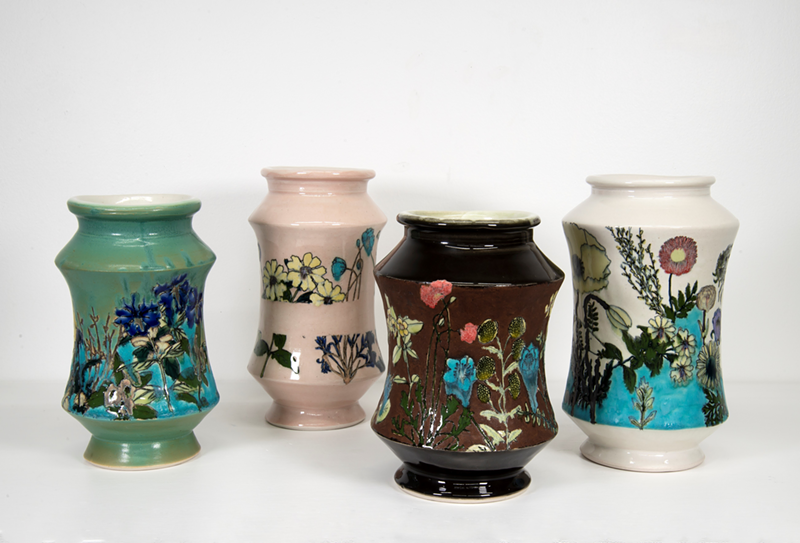Standing over a massive volume of Florae Austriacae — a 1770s illustrated guide to Austrian flowers by Dutch scientist Nikolas Joseph Jacquin, currently housed at downtown’s Lloyd Library and Museum — Guy Michael Davis reviews the difference between leaves and plates. A “leaf,” he clarifies, is an entire sheet of paper, front and back. A “plate” is the term for a single illustration on a page (one side of a leaf).
It’s simple library terminology necessary to classify the thousands of rare, sometimes centuries-old books on science, herbal medicine, botany and alchemy at the Lloyd. He and Katie Parker — the husband and wife duo behind local studio Future Retrieval and the Lloyd’s first-ever artists in residence — often encountered the term “leaves of plates” as they dug through the library’s vast collection.
Now, their months of research and studio time have culminated in a mixed-media exhibition — Leaves of Plates — inspired by the botanical illustrations found throughout the Lloyd’s volumes.
With an expertise in ceramics, Parker and Davis have gained recognition locally and beyond for their work centered around floral motifs and natural history, completing residencies at the Taft Museum of Art, through the Smithsonian Artist Research Fellowship (Davis at the National Museum of Natural History in Washington, D.C. and Parker at Cooper Hewitt in New York City) and the Iaspis, an international studio program in Stockholm, Sweden. Locally, their permanent installations can be seen at The Carnegie in Covington and Branch in East Walnut Hills.
They officially adopted the Future Retrieval moniker in 2008 after moving to Cincinnati to teach at the University of Cincinnati’s College of Design, Architecture, Art and Planning, naming themselves after a confusing legal term that appeared on their student loan forms.
“The way we work is that we kind of dig up old stuff and refresh it,” Davis says. “We were being very sarcastic and thought it was funny, and on the other hand it was actually very descriptive of our process.”
At first, Davis and Parker thought they might make a handful of ceramic pots for display at the library. Instead, they’ve managed to transform an entire room into a botanical wonderland. Larger-than-life-sized cardboard cutouts of mushrooms, foliage, dandelions and flowers of all kinds appear like giant versions of pop-up storybooks. In the center of the room, the pair has constructed a pseudo-scientific lab arranged from would-be alchemic devices. Ceramic stoves, Bunsen burners, beakers and bottles emulate the images Davis and Parker discovered in many of the Lloyd’s books, like an edition that chronicled Napoleon’s survey of Egypt in 1798 produced for the French government.
They also drew inspiration from a German manual on alchemy and philosophy from 1624 with incredible imagery depicting themes of duality: night and day, male and female, fire and water.
“If you’re looking in these very, very old books about early chemistry and medicine and science…they were looking for transmutation and the elixir of life,” Davis says. “There’s all these dueling, mirroring things. We’ve been responding to that as us.”
The walls are lined with several intricately detailed paper-cut works that imitate the gorgeous illustrations that once appeared in so many scientific texts. One shows a cluster of white, blue and orange-capped mushrooms sitting atop a log, while in another a singular, bright red poppy stands tall. A few, like a tangled tribe of other-worldly looking seaweed varieties, are replicas of works by the famed English botanical illustrator Elizabeth Twining.
Surrounded by an array of aluminum silhouettes of flowers and the like, Davis and Parker have created an assortment of floral-patterned apothecary jars — a nod to those once used by John Uri, Nelson Ashley and Curtis Gates Lloyd at the Lloyd Brothers Pharmacists beginning in 1885 (the three brothers founded the Lloyd Library and Museum). In addition to being avid collectors, the brothers also practiced eclectic medicine, which was popular in the late 19th and early 20th centuries and favored the use of botanical remedies.
Rookwood Pottery-esque with velvety matte glazes, Davis and Parker created upward of 30 drawings that were transferred onto the pots via a silk screen underglaze overlaid on the raw clay “like a temporary tattoo,” says Parker. The jars are displayed in Curtis Gates Lloyd’s original pre-Civil War library cabinet.
As it turns out, bringing the past to life is no small effort. Davis and Parker spent the first two months of their residency combing through and digitizing what they estimate to be at least 100 books, gravitating toward those where the artists had taken creative liberties.
They were initially trusted with just a few rare books at a time but soon had cartfuls of books all at once — including Florae Austriacae, a copy of which sold at auction for over $58,000 in 2014. Being trusted with the care of these books “felt like a really earned thing,” says Parker. “All stuff is precious and important, but it never felt like anything was off limits or untouchable or unusable.”
They also uncovered evidence of the human lives the books had touched before they ever found their way to the stacks at the Lloyd — the aforementioned 1624 German book had drawings and notes inscribed in the back pages, while others hid fern fronds pressed between their pages and even a London train ticket from the 1850s.
“It feels special. Like a discovery,” Parker says. “Each book we would pull, we would feel like, ‘Do people know this is here?’ We kept going deeper and deeper down this rabbit hole, finding some of the most gorgeous plant and botanical images we’ve ever seen. We found some things that I don’t think (the Lloyd) knew that they had.”
Leaves of Plates runs through Nov. 22 at the Lloyd Library and Museum. More info: lloydlibrary.org.







